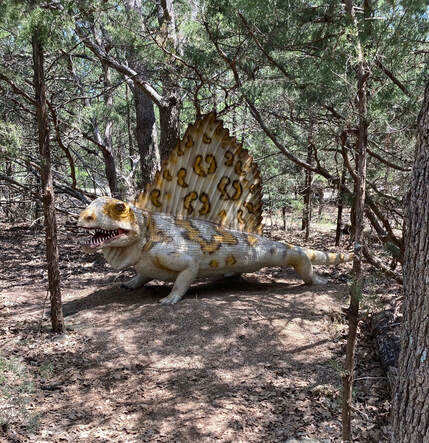|
Name: Dimetrodon
Pronunciation: die-Meh-troh-don Translation: Two measures of teeth Diet: Carnivore Height: 5 - 6 feet (1.5 – 1.8 meters) Length: 6 to 15 feet (1.8 – 4.6 meters) Weight: 62 - 550 Pounds (28 - 250 kg) Location: Texas, Oklahoma, Arizona, New Mexico, Utah, and Germany Time: Early Permian Period (295-270 MYA) |
Dimetrodon is often mistaken as a dinosaur, but this Permian Era creature actually went extinct around 40 million years before the first dinosaurs appeared in the Triassic Period. Dimetrodon is actually a “mammal-like reptile” classified as a synapsid, and is thought to be one of the earliest ancestors to all modern mammals. One of the primary features that identifies “true dinosaurs” is the position of their legs. Notice how Dimetrodon’s legs sprawl out to the side of the body; this is quite different from how dinosaurs’ legs are extended vertically under their body.
Dimetrodon was named for the varying sizes of large teeth in its mouth, with two distinct types of teeth for tearing and chewing, much like our own. Despite being named for its teeth, Dimetrodon’s most prominent feature is the large sail on its back. While this impressive feature gives Dimetrodon a distinctive look, scientists still debate what the purpose of this structure was. Some scientists believe the sail was used as a form of thermoregulation to heat or cool the body while others suggest it was more likely used as a display for courtship or to intimidate rivals.
Dimetrodon was an incredibly successful animal, so much so that over a dozen different species of Dimetrodon have been discovered. Many of these species were also thought to have been apex predators, with the largest of these animals being some of the most massive land predators of their time. Our exhibit showcases two fully grown adults of separate species, the smaller Dimetrodon limbatus, and the larger Dimetrodon angelensis.
Dimetrodon was named for the varying sizes of large teeth in its mouth, with two distinct types of teeth for tearing and chewing, much like our own. Despite being named for its teeth, Dimetrodon’s most prominent feature is the large sail on its back. While this impressive feature gives Dimetrodon a distinctive look, scientists still debate what the purpose of this structure was. Some scientists believe the sail was used as a form of thermoregulation to heat or cool the body while others suggest it was more likely used as a display for courtship or to intimidate rivals.
Dimetrodon was an incredibly successful animal, so much so that over a dozen different species of Dimetrodon have been discovered. Many of these species were also thought to have been apex predators, with the largest of these animals being some of the most massive land predators of their time. Our exhibit showcases two fully grown adults of separate species, the smaller Dimetrodon limbatus, and the larger Dimetrodon angelensis.

